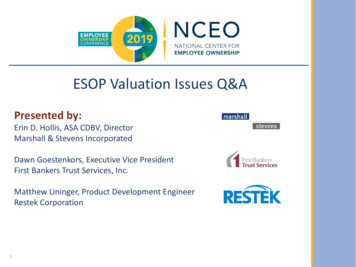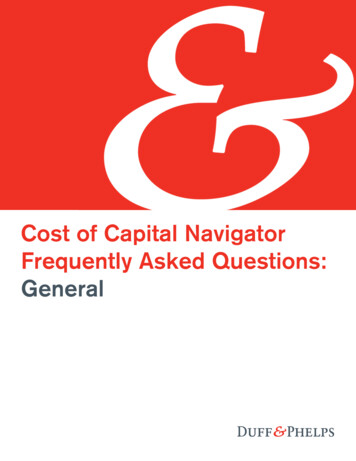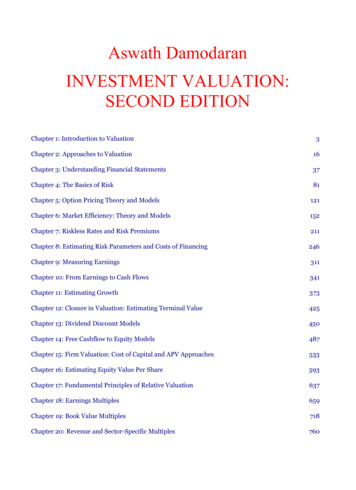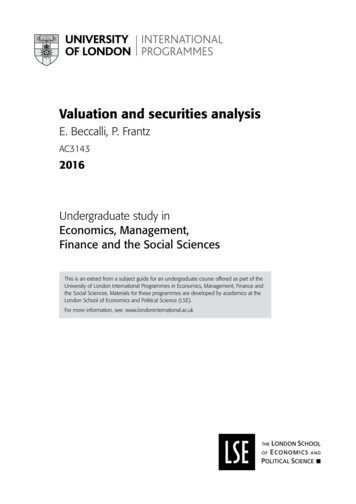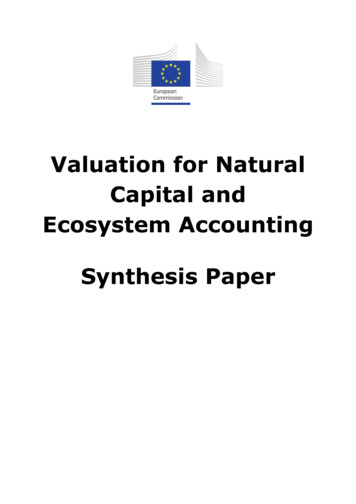
Transcription
Valuation for NaturalCapital andEcosystem AccountingSynthesis Paper
Valuation for Natural Capital and Ecosystem Accounting: Synthesis PaperPrepared for:The European Commission as part of a contract on the provision of technical support for thedevelopment of Natural Capital Accounting (Contract 07.0202/2017/767463/SERJENV.D.2), led byUNEP-WCMC in collaboration with IEEP and UEA CSERGE. This report was prepared University ofEast Anglia, Centre for Social and Economic Research on the Global Environment (CSERGE)Published September 2017CopyrightEuropean Union 2018. All rights reserved. Certain parts are licensed under conditions to the EUCitationBadura T., Ferrini S., Agarwala M. and Turner K. (2017) Valuation for Natural Capital and EcosystemAccounting. Synthesis report for the European Commission. Centre for Social and Economic Researchon the Global Environment, University of East Anglia. Norwich 2017.Disclaimer: The information and views ser out in this report are those of the authors and do notnecessarily reflect the official opinion of the Commission. The Commision does not guarantee theaccurancy of the data included in this study. Neither the Commission not any person actting on theCommission’s behalf may be held responsible for the use which may be made of the informationcontained therein.The Centre for Social and Economic Research on the Global Environment (CSERGE),University of East Anglia (UK), is internationally renowned for working at the forefront ofinterdisciplinary research, on a range of environmental issues. CSERGE research covers ahuge array of topics such as sustainable development, the relationship between humansand the environment, natural resource valuation and management, economic instruments,land use, water, energy, wetlands and coastal zone management, climate change,ecosystem services and natural resource accounting.Page 1 of 57
Table of Contents0INTRODUCTION31SUMMARY42BACKGROUND – NATIONAL AND WEALTH ACCOUNTING2.1Three approaches to natural capital accounting:3VALUATION IN/FOR NATURAL CAPITAL AND ECOSYSTEM ACCOUNTING193.1 Exchange and welfare value concepts3.1.1Simulated exchange values3.2 Valuing flows – ecosystem services3.2.1Valuing pollination3.2.2Valuing recreation services3.3 Stock valuation – monetary asset accounts11162123243539424KEY MESSAGES455BIBLIOGRAPHY476ANNEX51Page 2 of 57
0 IntroductionThis report aims to fulfil two objectives identified with the clients (i.e. KIP INCApartners and JRC in particular). These were to provide overviews1: 1) of the main issuessurrounding valuation methodologies in the context of ecosystem and natural capitalaccounting; and 2) of the possible approaches for valuing crop pollination and recreationwithin the Knowledge Innovation Project for an Integrated system for Natural Capital andecosystem services Accounting (KIP INCA). This report might be further expanded in thefuture to provide an extended discussion of the valuation methodologies in context of theKIP INCA future plans. The report provides a background for Technical Support actions inQ3 and Q4 2017, aiming to support the valuation work being undertaken at the JointResearch Centre.Following an extended summary, this report starts with a brief background on nationaland wealth accounting and sets out three possible generic approaches for future progress. Italso indicates how natural capital accounting can contribute to wider strategy and policyanalysis. It then discusses more specific issues related to valuation concepts such as exchangeand welfare values and their uses and limitations which are closely related to theoverarching purpose of the KIP INCA and its planned use of the derived information.Further, this report discusses the valuation approaches for flows of ecosystem services aswell as how it might be possible to value assets (stocks) as part of the KIP INCA.Complementary work has been undertaken for JRC covering specific ecosystem flowsvaluation in more detail (Fact sheets feedback). This material is provided in the Annex.We would like to keep this report as a living document that would be updated over theduration of this project. This would allow for further reflection on both empirical results anddata availability, resulting from Technical support Action, and the incorporation ofcomments and feedback from KIP INCA partners.1Please note that this report builds on an assumption of relative familiarity with the recent material and guidance documentsrelated to Natural Capital accounting. Namely, it is assumed that the reader is familiar with SEEA CF 2012, SEEA EEA 2012,SEEA EEA Draft Technical recommendation (2017). Please refer to these documents for further background and informationrelated to the recent discussions on environmental and economic accounting as well as ecosystem accounting practices.Page 3 of 57
1 SummaryNational income accounting is a method of collecting, organising and reportingdesirable information on economic activity which can assist in the measurement of trendsand decision making. It does not fully measure human welfare/wellbeing, nor does it includea comprehensive assessment of the impacts on the environment linked to the economicactivity. National accounts are human constructs, deliberately and strategically designed andhave always included a degree of pragmatism in their evolution. So what is included orexcluded from the national accounts is a matter of choice (Coyle 2014). The inclusion ofnatural capital into this accounting context is, we would argue, also a choice and one inwhich a degree of pragmatism is required.A significant problem associated with the inclusion of natural capital and ecosystemservices into the national accounts is that market prices and so-called exchange values areoften missing. This has led to efforts to ‘impute’ values (proxy exchange values) which haveto be indirectly measured or estimated. Production function data if available are especiallyuseful in this context. There also needs to be a recognition that the prevailing institutionalgovernance arrangements (e.g. property rights regimes, existing laws and regulations,cultural norms etc.) will condition the ‘imputed values’ that may be observed and calculated.We also note the criticisms from some conservationists that assigning monetary values tonature will end up in the complete ‘commodification’ of the environment. While such anoutcome would risk overemphasising the substitution possibilities between natural capitaland other forms of capital, as well as excluding the intrinsic value nature might possess, thisoutcome is not inevitable. A pluralistic approach to valuing nature has much to recommendit. With this line of reasoning it is possible to discern a number of value dimensions: thevalue elicitation process, and the source of the value information i.e. individual communitysocietal/cultural group; the value motivation i.e. self-regarding or other-regarding; theoverall institutional context; and the value scale i.e. to society or to the individual. What isrequired is a pragmatic view of environmental valuation which accepts that not all aspects ofnature can be meaningfully captured in money terms, but much can be treated in this wayand this could bolster conservation (Turner 2016). We outline in a succeeding section hownatural capital accounting incorporating monetary values can contribute to economicdevelopment plans and strategies at the national and regional level, as well as down at theproject/programme level. This pragmatic approach is mirrored in the history of nationalaccounting in debates over whether parts of the informal economy can be estimated in valueterms and included in the accounts. It is also the case that a significant amount ofGovernment spending does not directly reflect exchange values, although some is based oncosts of production.Page 4 of 57
As yet, natural capital lacks a widely agreed definition and a number of differentpossible approaches could claim to provide (with varying degrees of complexity, uncertaintyand practicality) natural capital accounting processes. Most prominently these include: Provide a limited extension to the measurement of economic activity via the mainnational income/capital accounts, or within the framework of the UN System ofNational Accounts (SNA)Compile physical accounts (based on, for example, land use and habitat units2) assatellite accounts, which highlight the contribution of the environment to theeconomy and societyCompile physical and monetary natural capital satellite accounts, which arecompatible with but separate from national income/capital accountsFully integrate natural capital and ecosystem services accounts into nationalaccountsCompile comprehensive social welfare wealth accounts (with economic welfarevalues linked to wellbeing) in line with sustainable development principles (weak orstrong)Compile corporate natural capital accounts (identifying firms’ dependencies andimpacts on natural capital in value terms).Because each of these approaches have different objectives and answer somewhat differentquestions, they require different data and, importantly, different values and valuationmethods. For simplicity, in the report we distinguish three broad approaches to naturalcapital accounting each with the following objective:1) Development of extended SNA type accounts to include more environmentalimpacts, but which still follow SNA conventions and restrictions on how economicactivity is measured (APPROACH ONE). This approach would hence be strictlybased on exchange value concept.2) Development of a separate set of (physical/monetary) Satellite natural capitalaccounts that can provide complementary information to SNA type accounts. Theywould serve to highlight the different contributions of the environment to the macroeconomy and hence allow for a degree of flexibility and fit-for-purpose design(APPROACH TWO). This approach could use different value concepts includingexchange and economic welfare values.3) Development of comprehensive social welfare Wealth accounts, these are dataintensive and require a full range of shadow values for monetary valuation purposesin order to capture wellbeing (APPROACH THREE).In the SEEA context the relevant spatial statistical units are Basic statistical units (BSUs), Ecosystem Assets (EA)and Ecosystem Accounting Area (EEA). See SEEA EEA 2017 for further details.2Page 5 of 57
The choice made between these different approaches will determine the form andextent of any new accounting system and appropriate economic valuation methods. But theapproaches are not mutually exclusive. For example, information could be transferred fromthe second to the first or to the third as knowledge improves and/or changes in accountingpractices are agreed. Similarly, information from accounts based on one approach could beused to complement accounts based on another approach for specific policy requirements.The first of these approaches (APPROACH ONE) it has been argued, limits the type ofvalues that can be utilised to incorporate environmental impacts into a monetary account.From this viewpoint only exchange values can be used, although some analysts have madethe case for a wider inclusion of externality effects (Vincent 2015).Taking the example of apositive externality where an ecosystem provides a service that is an input used by a firm toincrease production, the input value could be interpreted as an implicit exchange value. Theinput value would be measured in terms of the value of the additional output produced bythe firm, and Vincent (2015) has argued that this is the maximum amount a producer wouldbe willing to pay for the ecosystem service if a market actually existed. If this approach is tobe generalised a number of practical measurement problems would need to be overcome.The second approach (APPROACH TWO) aims to bring together a separate set of satellite(physical/monetary) accounts covering ecosystem services assets (stock) and services (flows).The objective is to ‘mirror’ changes in economic activity (expressed in the SNA typeaccounts) with a set of ‘environmental’ accounts which quantify and value the consequencesof economic activity as it impinges on the environment and society through various driversand pressures. An agreed baseline position and timeline is required, but a wider range ofplural values can be utilised e.g. exchange and economic welfare values plus others.The third approach (APPROACH THREE) attempts to provide a comprehensive socialwelfare based wealth account in monetary terms (economic welfare values). These accountswould aim to reflect the fullest possible quantification of capital assets and economic andsocial wellbeing impacts (including for example health and education) in order to achievesustainable development.The three approaches to natural capital accounting can play a diverse number of roles in thepolicy process. At a strategic level (e.g. promotion of the Circular Economy strategy),quantifying the natural capital asset base and the benefits it provides to the economy andsociety represents an important component of a national or regional economic developmentstrategy. Such an approach would seek to increase resource use efficiency, increase resourcesupply security and promote eco-innovation, thereby raising the overall productivity of theeconomy. A monitoring system for natural capital can identify gaps in knowledge and leadto a risk register (Mace et al 2015) together with information on ‘critical natural capital’limits. Prior identification of the pressures, drivers and threats/opportunities to naturalPage 6 of 57
capital can facilitate the move to sustainable development paths. It may also be possible toinvestigate societal inequalities by augmenting income data (Gini coefficient) with naturalcapital provision and access data. At the enabling/implementation level natural capitalaccounting can help in the assessment of the effectiveness of prevailing policy instrumentsand the practicability of policy objectives, or future policy options. The same accountinginformation can also play a role in individual project/programme assessment (see forexample the Balance Sheet approach (UK NEA Follow On 2014; Turner 2016).The natural capital accounting system generally conceptualises the ecosystem as theasset (stock), rather than the constituent parts. The assets are described in terms of aparticular land cover class or ecosystem type and in terms of their extent and condition. Heinet al (2016) provide additional concept ideas relating to ecosystem assets, they argue thatcapacity, capability to supply services and the potential supply of services are necessarymeasures for accounting. These notions are closely related to sustainability and criticalnatural capital limits and thresholds thinking. The distinction between intermediate servicesand final ecosystem service flows used by beneficiaries, also needs to be borne in mind(Boyd and Banzhaf 2007; Fisher et al 2009). Physical accounts classify and record the extent,condition of and annual service flow from ecosystem assets. Monetary accounts putmonetary values (point estimates) on final ecosystem services on an annual basis, or on thecapacity to produce future flows of final services. There is a further choice to be made onmonetary values: welfare and/or exchange values. The former reflect the willingness to payfor goods and services, regardless of whether they are exchanged for cash, or how much cashthey would be exchanged for if they were exchanged. The latter are the value at which flowsand stocks are in fact, or could be, exchanged for cash. Market prices are the reference forvaluation in most official guidance (e.g. OECD 2009). The guidance continues to covercontexts in which no market price is available and recommends that if costs are also notavailable, then stocks and flows may be valued, as a last resort, at the discounted presentvalue of expected returns. We take a closer look at valuation methods for ecosystem servicesin a later section, along with some pragmatic guiding principles.But other problems and choices also loom large in this accounting context. It isimportant to clearly distinguish between stock and flow concepts. The SEEA EEA3 definesthe ecosystem stock account in terms of the extent or volume of the asset and its condition orquality, at the start and end of a year. The services account shows flows over a given periodof time, but with the complication that some cross-cutting service accounts will be necessary3SEEA EEA refers to the report published by United Nations, European Commission, Food and Agricultural Organization ofthe United Nations, Organisation for Economic Co-operation and Development, The World Bank (2014b) System ofEnvironmental-Economic Accounting 2012 – Experimental Ecosystem Accounting. United Nations, New YorkPage 7 of 57
in cases where some services are provided by a number of habitats. A particularly difficultchallenge is posed when there is uncertainty over the sustainability of a given stock underuse pressure or environmental change. The use of point estimates for ecosystem servicesvalues when non-marginal stock changes occur and thresholds are crossed is problematic.The development of ‘red flag’ (e.g. UK NEAFO 2014) warning measures in the physicalaccounts needs urgent attention given the uncertainties over threshold effects. If a strongsustainability position is accepted then restoration costs may play a role in any satelliteaccount.Stock (asset) sustainability and lifetime questions are important and add a further levelof complication to the accounting task. Hein et al (2016) have put a new emphasis onecosystem capacity and capacity accounts. The capacity relates to the sustainable rate ofusage of a ‘bundle’ of ecosystem services and represents an important link to long termviability of an asset. This link is not reflected in the currently proposed approach to assetvaluation relying on a net present value basis for an expected flow of ecosystem services. In asatellite account, UK ONS (2017) has suggested a proxy approach in which a minimumrestoration/ replacement cost would be charged and summed over the asset lifetime(undiscounted). The acceptance of a strong sustainability worldview (with its constantcapital rule) is critical to this sort of proxy method and does not fit easily into SNA practice.There is some debate over whether restoration costs are or are not equivalent to assetdepreciation in national accounts. On an annual basis, the latter represents the cost ofreplacing the asset in its depreciated state, but the sum over all annual depreciation chargesis equivalent to the cost of replacing the asset in its non-depreciated state.The use of replacement cost values will also be conditioned by the institutional /policycontext. Taking water purification as an example, this is strictly an intermediate ecosystemservice which yields the final service, clean water which has an economic benefit value toconsumers. However, if a formal water quality standards regime is in place then a valuecomparison between a wetland providing a natural purification service and a watertreatment facility is a valid procedure. The costs of the two alternatives could be compared inorder to derive a cost effective solution.Asset lifetime considerations bring in the question of an appropriate discount rate.Most environmental economists agree that for environmental long lived assets a discountrate based on market rates is not appropriate. Markets are essentially driven by short termconsiderations. So for ecosystem assets a capacity and accounting lifetime of 100years seemsreasonable, together with a declining discount rate such as that adopted in the UK, based onthe Ramsey formula (e.g. ONS 2017).The distinction between stock and flow has also been recently highlighted in work inthe USA (Fenichel and Abbott 2014, Fenichel et al., 2016). This line of argument seeks to keepPage 8 of 57
natural capital separate from ecosystem services by linking natural capital more formally tonational capital accounts, with ecosystem services classified as part of the national incomeaccount. A complication with this stream of research is the necessity to accommodate the“scarcity effect” of natural capital depletion and the effect on market prices. This problemseems to have been overcome in some empirical cases on groundwater and fisheriescompiled by these analysts (see sections in the main report).The environmental economics literature now contains a range of tried and testedvaluation methods and techniques for market and non-market goods and services which canin principle be used to value ecosystem services flows. For accounting purposes a clear,explicit and consistent application of valuation methods is important. For example, ONS(2017) have suggested a number of principles as guidance in the valuation process which wehave reinterpreted as follows: Use of a particular technique should be clearly explained and related to theunderlying biophysical assessment processValuation methods should be transparent, intuitive and replicableWhere possible calculated values should be compartmentalised into their ‘price’ and‘quantity’ components‘Benefits transfer’ potential for using available estimates should be explored withcaution.Four broad categories of valuation methods are potentially available:Market-based methods (using market price values)Revealed preference methods (related to the behaviour of individuals and theexpenditure they incur) Cost-based methods Stated preference methods (related to the answers provided by individuals whenresponding to survey questions about their willingness to pay for something). A fuller discussion of these methods is provided in a later section of this report.The diverse range of methods for valuing flows of ecosystem services (e.g. Freeman etal 2013) that are available to some extent reflect the prevailing set of different policyobjectives and contexts. An important first step in the process of developing natural capitalaccounts is to get clarity and agreement on the broad approaches to accounting and therelated policy objectives. For example, while more effort might be put into developing a fullset of SNA-compatible natural capital accounts, specific satellite ecosystem service accountsmight also be constructed to provide complementary information (e.g. pollination accounts).The ultimate objective of development of natural capital accounts is facilitation ofbetter-informed decision making. The debate surrounding the use of valuation methods forPage 9 of 57
the natural accounts is far from settled. Since both the potential use and possiblemethodologies are not yet fully clarified, we would argue that an open approach in thecontext of KIP INCA might be taken to valuation methodologies. Nevertheless, thispragmatism should involve a clear identification of and clear specification of the agreedgoals for the use of accounts. The work within the KIP INCA context allows grounds fortesting some of the approaches as well as comparing results under different approaches. Thisis an opportunity that should be fully, but carefully, exploited.Page 10 of 57
2 Background – national and wealth accountingCurrent macroeconomic decision making is largely guided by the information derivedfrom the System of National Accounts (SNA; EC et. al. 2009) and its flagship policy indicator,the Gross Domestic Product (GDP). Despite its frequent and (unfortunately) common publicinterpretation as a welfare index, GDP does not provide a comprehensive picture of welfarechanges (Dasgupta 2009). It is clearly a fundamental component of overall wellbeing and isa necessary but not sufficient measure of welfare. GDP is a gross flow measure, building onSNA’s objective to “compile measures of economic activity in accordance with strictaccounting conventions based on economic principles” (EC et. al. 2009, para 1.1). It accountsfor flows of economic activities for a specified accounting period, however it omits somenon-market goods and services. This has consequences for environmental protection policy.Rather than GDP, a stock of wealth indicator is required to measure intertemporalsustainable growth and development progress.Recent decades have seen an increased realisation of the need to better understand andmanage the relationship between human society and the environment. Decreases inenvironmental quality have led to calls for improvement in our measurement systems forsustainable development. A spectrum of approaches can be envisaged for this task. On oneend of this spectrum are different variants of a limited extension of national accounting thatincorporate environmental and ecosystem assets into its measurement system4. Theenvironmental and ecosystem accounts could also be constructed as satellite accounts thatare not integrated within the SNA system. These could be biophysical only, or alsoencompass monetary accounts. A future and ambitious goal might be to fully integrateecosystem services into SNA system. At the other end of the spectrum of approaches tonatural capital accounting is wealth accounting. On a conceptual basis, some of theseapproaches differ in the focus of their measurement systems and hence their ultimateusability potential for policy making. While national accounting is focused on the flows ofeconomic activity over an accounting period (usually a year), wealth accounting focuses onthe changes in the (as far as possible) comprehensive set of stocks of capital assetsunderpinning economic growth. In other words, national income accounting focusespredominantly on the (changes in) flow of economic activities, wealth accounting aims tomeasure (changes in) stocks of assets that condition the flows. These different approachesoffer useful insights for policy making and present different, and to certain extent4Note that, due to focus of this report on the accounting for environmental and ecosystem goods and services, we omit in thefollowing discussion the social dimension of sustainable development. Nonetheless a substantial progress has been made inunderstanding and data collection on indicators related to social capital.Page 11 of 57
complementary, alternatives and context for assessment of economic growth anddevelopment. We feel that it is important to keep in mind the different possibilities for theKIP INCA.As it is predominantly focused on market activity5, SNA is missing importantinformation that is relevant for the assessment of growth in its broadest sense. Indeed,important omissions of SNA’s measurements have been discussed since its inception in the1950’s. Some contributions to economic activity are not reflected in the national accounts. Inparticular, as a systematic measurement tool of economic activity, that aims to measureoutput in terms of goods and services exchanged in markets, national accounting omitseconomically, socially and environmentally important non-market goods and services. Froman economic point of view, for example, the SNA disregards unpaid work that takes place athome which might significantly skew the view of economic production and economicgrowth (see e.g. Landefeld and McCulla 2000). Similarly, a number of ecosystem relatedgoods and services (e.g. soil formation, fish nursery grounds) that support economic activityare invisible in the SNA in the sense that they are implicit, but not explicit in theircontribution to production (e.g. food production, fisheries). Other ecosystem related goodsand services are omitted from the SNA in different ways. Their role in supporting humanwellbeing is not explicitly recognized and while some can be included in the prices of othergoods and services (e.g. amenity value of landscapes increasing property prices or increasedtourism revenue in the area), in some cases their value is ignored altogether (e.g. the valueascribed to an existence of endangered species or the carbon sequestration and storage valueof some vegetation covers). An underestimation of the role of the environment in economicand other human activity contributes to inefficient management and potential environmentaldegradation.Recent efforts, especially the System of Environmental-Economic Accounting, CentralFramework and Experimental Ecosystem Accounting (SEEA CF6 and SEEA EEA) aim toextend and integrate the national accounts for environmental and ecosystem assets.Ecosystems are viewed as assets that contribute to SNA-measured economic activity, butalso as assets that generate economic and human activity outside of SNA’s currentmeasurement system. This extension might effectively allow a) understanding how mucheconomic activities are dependent and/or impact on environmental and ecosystems assetsand b) extending the measurement of national accounts to some ecosystem services thatWe acknowledge that SNA includes the public services provides by Government (such as schooling, hospitals, defence and soon). It breaks these down into collective and individual public goods. But valuation is on the basis of the cost of providing thoseservices.6 SEEA CF refers to the report published by United Nations, European Commission, Food and Agricultural Organization of theUnited Nations, International Monetary Fund, Organisation for Economic Co-operation and Development, The World Bank(2014a) System of Environmental-Economic Accounting 2012 – Central Framework. United Nations, New York5Page 12 of 57
contribute to human wellbeing that were previously fully or partially missing in nationalaccounting (e.g. air and water purification provided by various vegetation types).SNA and SEEA measure flows and stocks related to economic and human activity bycollecting, organising and reporting associated information. The SEEA’s major addition toSNA is the collection of physical data related to environment and ecosystems and theorganisation of it in a coherent manne
2 BACKGROUND - NATIONAL AND WEALTH ACCOUNTING 11 2.1 Three approaches to natural capital accounting: 16 3 VALUATION IN/FOR NATURAL CAPITAL AND ECOSYSTEM ACCOUNTING 19 3.1 Exchange and welfare value concepts 21 3.1.1 Simulated exchange values 23 3.2 Valuing flows - ecosystem services 24 3.2.1 Valuing pollination 35
